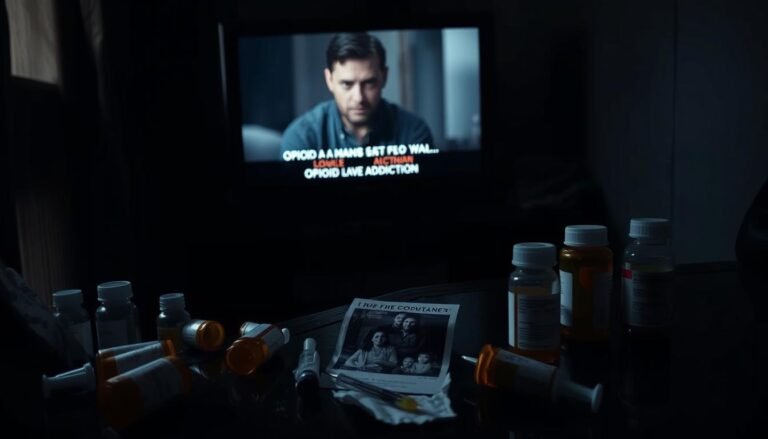Identifying the Signs of Drug Abuse
Ever thought someone close to you might be fighting drug addiction? Knowing the signs is key to helping them early. With 65.7% of people aged 12 and up using alcohol last year, and 17.8% using illegal drugs, it’s a big issue. Spotting drug addiction can really help someone get better.
Substance use disorders can show up in many ways. This includes using legal stuff like alcohol and prescription meds, and illegal drugs too. People often keep using even when it really hurts their lives. By spotting the substance abuse warning signs, we can help them get the help they need.
In this article, I’ll show you how to spot drug addiction. We’ll look at changes in behavior and physical signs. This will help you know how to help someone who might be struggling.
Key Takeaways
- Identify common signs of drug addiction early to facilitate intervention.
- Understand the prevalence of substance use disorders among adolescents and adults.
- Recognize behavioral and physical changes that indicate drug abuse.
- Learn about specific signs linked to various drugs.
- Discover resources for support and recovery.
Understanding Drug Addiction
Drug addiction is a complex disease that affects not just the person but also their loved ones. It often starts with casual use and quickly turns into a serious problem. Opioid painkillers, for instance, can lead to addiction even with a doctor’s prescription.
It’s important to know the drug addiction symptoms that show a problem. For example, someone might need to use the drug every day or spend all their money on it. These substance use disorder indicators help spot issues early and get help sooner.
Behavioral signs of addiction vary by drug. Marijuana can make eyes red and coordination hard. Meth and cocaine make people feel very alert and talk fast.
Other drugs have scary effects too. Synthetic cannabinoids can cause extreme anxiety and hallucinations. Prescription drugs like barbiturates and benzodiazepines make people sleepy and slur their words. Club drugs like ecstasy and GHB can lead to hallucinations and muscle cramps. Hallucinogens like LSD can make people act impulsively and feel very emotional.
About 50% of addiction risk comes from genetics. This makes it even more important for families, schools, and communities to learn about it. Teachers and healthcare providers are key in preventing addiction.
Understanding addiction shows that treatments combining medicine and therapy work best. Recovery is a long journey, with many at risk of relapse. In 2019, over 20 million Americans aged 12 and older struggled with substance use disorder. This shows we need better prevention and treatment now.
What is Substance Use Disorder?
Substance use disorder is a chronic condition that affects many people. It is marked by compulsive substance use, even when it’s harmful. People start using drugs for many reasons, like feeling good or because of peer pressure.
This disorder includes many substances, like alcohol, cannabis, and opioids. The National Institute on Drug Abuse says treatment often involves medication and therapy. It’s important to tailor treatment to each person, as there’s no one-size-fits-all solution.
Research has found thirteen key principles for treating drug addiction. Recovery is possible with the right support. Sadly, many who could benefit from treatment don’t get it. This shows we need to make treatment more accessible.
Over one in four adults with serious mental health issues also face substance use problems. This shows a strong link between mental health and substance use disorders. Recognizing the signs of substance use disorders early can help get people the help they need.
Signs of Drug Addiction Symptoms
Drug addiction shows itself in many ways, affecting both how people act and their bodies. People might feel an intense need to use the drug, ignoring important tasks. When they can’t get the drug, they might show withdrawal symptoms, showing how serious the problem is.
Behavior changes are common, like making new friends who also use drugs. This can lead to feeling isolated from old friends and family. People might also ignore personal care, like not washing their hands or taking care of their hair and nails.
- Impaired control over substance use
- Significant fluctuations in weight
- Increased secrecy and withdrawal from social activities
- Possession of drug paraphernalia
Physical signs of addiction are also clear. People might look unhealthy, with flushed cheeks, unusual bruises, and gum disease. About 56% of those with addiction have gum disease. Other signs include bloodshot eyes, sweating, tremors, and changes in sleep.
Drug addiction also affects the mind and social life. It can make it hard to make decisions, increase anxiety, and lead to depression. Spotting these signs early is key to helping someone get the help they need.
Recognizing Drug Addiction in Adolescents
Spotting drug addiction in teens can be hard. Their behaviors often seem like normal ups and downs of being a teenager. But, big changes in behavior might mean they’re using drugs. For example, if a teen starts avoiding family, does poorly in school, or changes friends, it could be a sign.
Many teens try drugs. About 70% of U.S. high school students have had alcohol by graduation. And, 22% of 12th graders use marijuana in the last month. These numbers show why we need to watch for signs of addiction.
- Changes in behavior, like being secretive or avoiding eye contact, are important signs.
- Poor hygiene, bloodshot eyes, and mood swings can also mean drug use.
- Being friends with risky peers can lead to bad choices.
Talking openly about drug use with teens is key. Studies say talking about risks can cut substance misuse by up to 50%. It’s not just about knowing the signs. It’s about building trust and making sure they feel safe sharing their struggles.
Common Behavioral Signs of Drug Abuse
Spotting behavioral signs of drug addiction can be tough but very important. Friends and family might see more secrecy and less socializing. This can lead to ignoring work or home duties, straining relationships.
Feeling guilty or ashamed, people might get defensive about their drug use. This can show in many ways, like:
- Hiding drug or alcohol use from others
- Making excuses for using substances
- Choosing substance use over responsibilities
- Changing friendship circles, often distancing from supportive relationships
Other addictive behaviors include poor personal hygiene and changes in routine. For example, sleep patterns might get disrupted. This can make it hard to stay awake or fall asleep at the right times.
Needing more of a substance to feel normal is a red flag. Using drugs or alcohol to avoid withdrawal symptoms is also concerning. Even using substances in risky ways can increase dangers. Mood swings and extreme personality changes can also strain relationships.
Here’s a table to help spot these signs:
| Behavioral Signs | Description |
|---|---|
| Secrecy | Concealing use from friends or family |
| Withdrawal | Avoiding social situations and neglecting responsibilities |
| Defensiveness | Getting irritated or angry when asked about substance use |
| Change in Social Circles | Developing new friendships that revolve around drug use |
| Decline in Personal Care | Showing less interest in hygiene and grooming |
Knowing these behavioral signs of drug addiction is key to helping someone. Talking openly about these issues can help create a safe space for healing.
Physical Symptoms Related to Drug Use
Physical symptoms can show if someone is struggling with addiction. It’s key to spot these signs early. They often point to a bigger problem, like drug dependency. Here, we’ll look at how changes in appearance and health can signal drug dependency.
Changes in Appearance
Substance use can lead to noticeable changes in how someone looks. This might include:
- Poor hygiene and grooming habits
- Weight changes, like losing or gaining a lot of weight
- Skin problems, like infections or sores, from injecting drugs
- Bloodshot or red eyes
- Unusual body smells
These changes are concerning and shouldn’t be ignored. They show the physical and mental effects of drug use.
Physical Health Declines
When someone’s health starts to decline, it’s a sign of drug dependency. They might face serious health problems, such as:
| Drug Type | Common Health Issues |
|---|---|
| Alcohol | Liver disease, stomach problems |
| Cocaine | Heart issues, breathing problems |
| Opioids | Constipation, risk of overdose |
| Stimulants | Fast heart rate, anxiety |
| Anabolic Steroids | Hormonal imbalances, heart problems |
These health issues show the need for quick action. Spotting these signs early can help in getting the right treatment and starting recovery.

Financial and Social Indicators of Substance Abuse
Looking at the financial signs of substance abuse shows how addiction can change a person’s life. People with addiction often choose to buy substances over basic needs like food and a place to live. Asking for money or suddenly not showing up for work are red flags for those around them.
These actions show a big change where substance use takes over someone’s life.
The social effects of addiction are also serious. People with addiction may pull away from friends and family to use substances. Loved ones might see someone becoming isolated and neglecting important tasks. Time spent with family is replaced by getting or using drugs, showing a big change in what’s important.
This isolation makes people feel lonely and desperate, making things worse.
The table below outlines some common financial and social indicators that may arise in someone struggling with substance abuse:
| Indicator | Description |
|---|---|
| Loss of Control | Inability to stop using despite repeated attempts. |
| Preoccupation with Use | Spending a significant amount of time obtaining or recovering from substances. |
| Tolerance | Needing increasingly larger amounts of substances to achieve desired effects. |
| Withdrawal Symptoms | Experiencing physical or psychological symptoms when attempting to cut down. |
| Neglect of Responsibilities | Prioritizing substance use over obligations such as work or family. |
| Social Isolation | Withdrawing from social activities in favor of substance use. |
Spotting these signs early can help. Knowing how serious these signs are can push people to get help. It also lets family members talk about it before things get worse.
Emotional and Psychological Signs of Addiction
It’s important to know the emotional and psychological signs of addiction. Addiction affects more than just physical health. It also impacts emotional well-being and mental stability. Recognizing these signs is a key step in seeking help and starting the recovery journey.
Common Psychological Symptoms
Emotional signs of addiction show up in many ways. Mood swings are a big indicator, making people feel unpredictable. Here are some common symptoms:
- Increased anxiety: This includes symptoms such as excessive worrying, rapid heartbeat, and restlessness.
- Feelings of depression: People may feel hopeless, irritable, and lose interest in things they used to enjoy.
- Withdrawal from social activities: A common response includes distancing oneself from friends and family.
- Increased secrecy: Addicts may hide their behaviors or lie about their whereabouts.
- Neglecting responsibilities: They may struggle to meet work, school, or family obligations.
Impact on Relationships
Substance use can severely affect relationships, creating a ripple effect of distress. The emotional signs of addiction often lead to harmful changes in how people interact with each other.
| Emotional Sign | Impact on Relationship |
|---|---|
| Mood Swings | May lead to conflict and misunderstandings. |
| Increased Anxiety | Can cause withdrawal from loved ones and increase feelings of isolation. |
| Secrecy | Destroys trust and may drive a wedge between partners and friends. |
| Depression | Can make individuals less available emotionally, straining connections. |

How Drugs Affect Performance in Daily Life
Drugs can really change how we live our lives. They can make it hard to work, study, and keep good relationships. Using drugs regularly can make us miss school or work. It also makes it tough to focus, leading to less work done and even losing a job.
Looking at signs-of-drug-addiction effects shows how drugs mess with our brains. Adults might forget things and have trouble paying attention. This can cause them to make bad choices, hurting their work relationships.
Drugs also hurt young people a lot. They might take risks that lead to school problems, unplanned pregnancies, and danger. Their grades can drop, showing how drugs can ruin chances for the future.
But it’s not just the users who suffer. Families where parents use drugs can be very stressful. This stress can lead to neglect or abuse of children, starting a cycle of addiction that lasts for generations.
| Impact Area | Details |
|---|---|
| Academic Performance | Adolescents often perform poorly, with increased dropout rates and risky behaviors. |
| Professional Outcomes | Adults experience a decline in cognitive abilities, affecting work performance and relationships. |
| Family Environment | Parents’ drug abuse creates chaotic households, leading to child abuse and neglect. |
| Health Risks | Drug and alcohol abuse results in chronic health issues and increases risks for infectious diseases. |
Seeing how drugs affect our daily lives shows we need help. By spotting the signs-of-drug-addiction effects, we can help people get back on track. This way, we can all live healthier lives.
Identifying the Signs of Drug Addiction
Understanding the signs of drug addiction is key. It helps in early intervention. These signs can show up in behavior, physical health, and emotions. They vary based on the drug used.
Tolerance is a common sign, where more of the drug is needed to feel the same effects. For opioids, look for lethargy, slow breathing, and mental issues like anxiety and depression. There’s also a risk of overdose, with symptoms like vomiting and irregular breathing.
Keep an eye out for changes in behavior. Signs include:
- Secrecy and withdrawal from usual activities
- Financial strain due to spending on drugs
- Neglecting work or personal responsibilities
- Engaging in risky behavior like stealing for substance procurement
Trying to quit can lead to withdrawal symptoms. This makes it hard to stop using drugs. It can also lead to daily use, neglecting responsibilities. A sudden need for money or missing items often points to a drug problem.
Long-term effects include decreased mental sharpness and social isolation. It’s important for families to talk openly. This can help individuals seek help without fear of judgment.
Conclusion
Recognizing drug addiction is key to helping people early on. Addiction is a serious, ongoing issue that impacts many lives. By spotting changes in behavior, physical signs, and emotional struggles, we can take action.
Early detection is critical for recovery. It helps avoid serious problems linked to drug use. This is why spotting addiction signs is so important.
My own experiences show the importance of staying alert and caring for those with addiction. The road to recovery is complex, shaped by many factors. Yet, with the right help, change is possible.
Access to treatment is essential. This can include counseling, medication, or community support. It’s vital for recovery.
In conclusion, let’s work together to raise awareness about drug addiction. We all have a part to play in tackling this issue. By doing so, we can help people live healthier, drug-free lives.






